Mobile Application Project: Healthy Lifestyle for Sri Lankans
VerifiedAdded on 2023/02/06
|33
|12465
|88
Project
AI Summary
This project report details the development of a health mobile application designed to foster healthy lifestyles and prevent non-communicable diseases, particularly within Sri Lanka. The application aims to transform unhealthy eating habits and sedentary lifestyles into healthy ones by encouraging users to share experiences, photos, and videos related to healthy living. It also facilitates connections with dieticians, doctors, and nutritionists. The project's significance lies in its potential to address the growing prevalence of non-communicable diseases through community engagement. The report includes a literature review covering social networking sites, mHealth applications, and persuasive technology in healthcare. The methodology involves a cross-sectional study using a sample of participants in Southern Sri Lanka, with data collection via interviewer-administered questionnaires. The objectives include promoting healthy eating, fostering an active lifestyle, and creating a community-driven approach to health. The value proposition emphasizes smooth transitions to healthier habits, disease prevention, and the enjoyment of favorite foods. The report also discusses the limitations of the study, such as the use of chi-square tests, potential project management challenges, and concerns about user privacy.
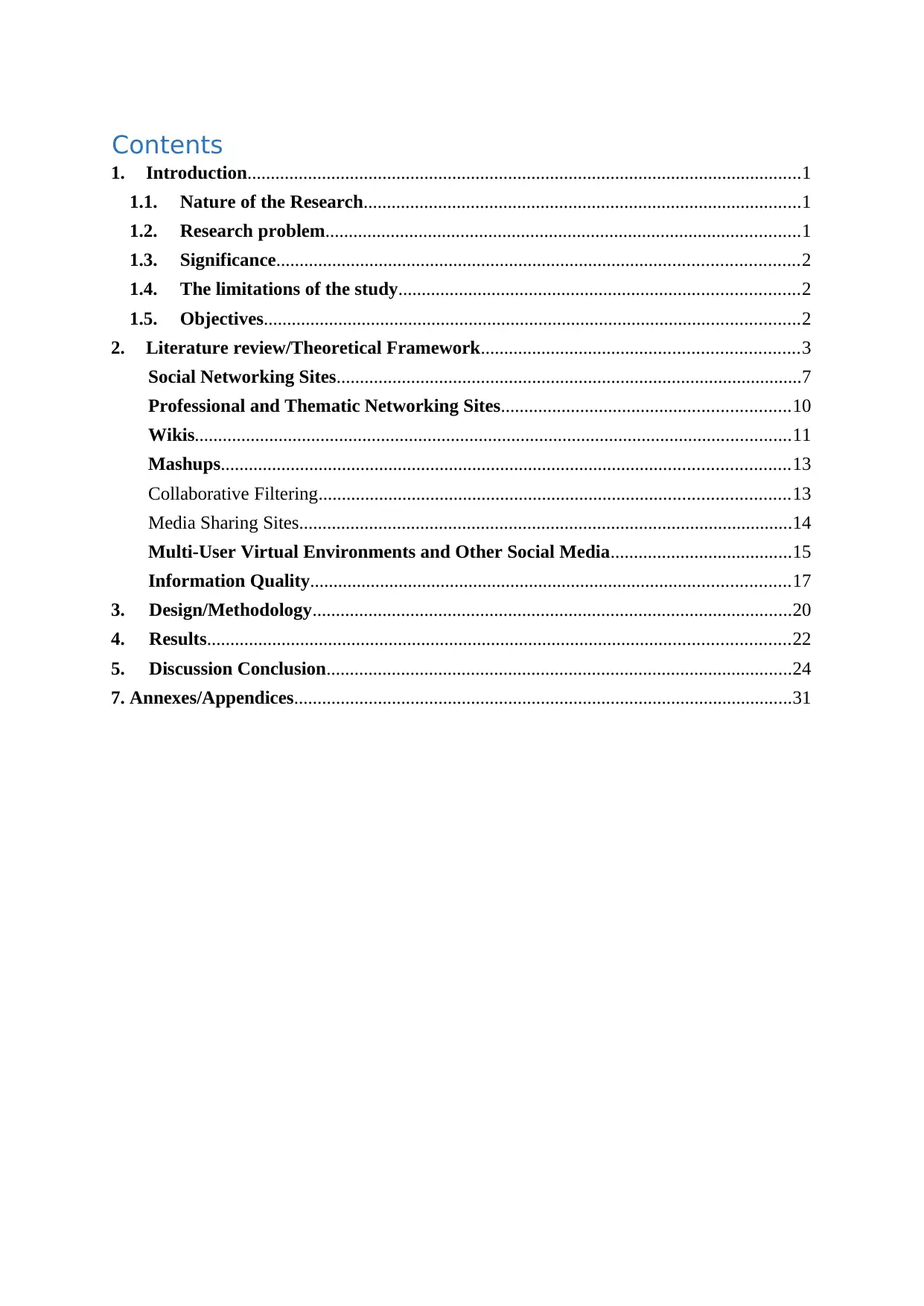
Contents
1. Introduction.......................................................................................................................1
1.1. Nature of the Research..............................................................................................1
1.2. Research problem......................................................................................................1
1.3. Significance................................................................................................................2
1.4. The limitations of the study......................................................................................2
1.5. Objectives...................................................................................................................2
2. Literature review/Theoretical Framework....................................................................3
Social Networking Sites....................................................................................................7
Professional and Thematic Networking Sites..............................................................10
Wikis................................................................................................................................11
Mashups..........................................................................................................................13
Collaborative Filtering.....................................................................................................13
Media Sharing Sites..........................................................................................................14
Multi-User Virtual Environments and Other Social Media.......................................15
Information Quality.......................................................................................................17
3. Design/Methodology.......................................................................................................20
4. Results.............................................................................................................................22
5. Discussion Conclusion....................................................................................................24
7. Annexes/Appendices...........................................................................................................31
1. Introduction.......................................................................................................................1
1.1. Nature of the Research..............................................................................................1
1.2. Research problem......................................................................................................1
1.3. Significance................................................................................................................2
1.4. The limitations of the study......................................................................................2
1.5. Objectives...................................................................................................................2
2. Literature review/Theoretical Framework....................................................................3
Social Networking Sites....................................................................................................7
Professional and Thematic Networking Sites..............................................................10
Wikis................................................................................................................................11
Mashups..........................................................................................................................13
Collaborative Filtering.....................................................................................................13
Media Sharing Sites..........................................................................................................14
Multi-User Virtual Environments and Other Social Media.......................................15
Information Quality.......................................................................................................17
3. Design/Methodology.......................................................................................................20
4. Results.............................................................................................................................22
5. Discussion Conclusion....................................................................................................24
7. Annexes/Appendices...........................................................................................................31
Paraphrase This Document
Need a fresh take? Get an instant paraphrase of this document with our AI Paraphraser
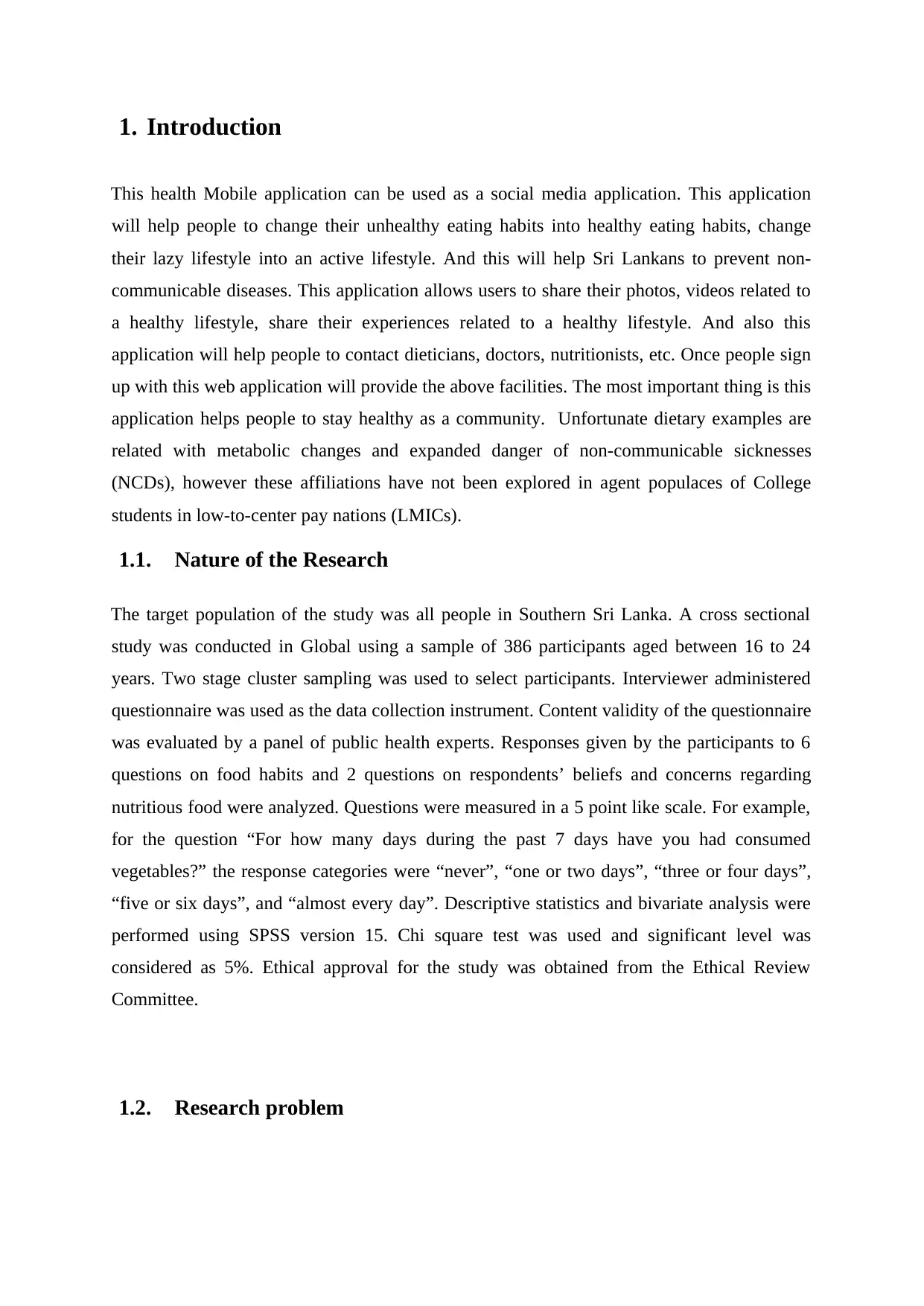
1. Introduction
This health Mobile application can be used as a social media application. This application
will help people to change their unhealthy eating habits into healthy eating habits, change
their lazy lifestyle into an active lifestyle. And this will help Sri Lankans to prevent non-
communicable diseases. This application allows users to share their photos, videos related to
a healthy lifestyle, share their experiences related to a healthy lifestyle. And also this
application will help people to contact dieticians, doctors, nutritionists, etc. Once people sign
up with this web application will provide the above facilities. The most important thing is this
application helps people to stay healthy as a community. Unfortunate dietary examples are
related with metabolic changes and expanded danger of non-communicable sicknesses
(NCDs), however these affiliations have not been explored in agent populaces of College
students in low-to-center pay nations (LMICs).
1.1. Nature of the Research
The target population of the study was all people in Southern Sri Lanka. A cross sectional
study was conducted in Global using a sample of 386 participants aged between 16 to 24
years. Two stage cluster sampling was used to select participants. Interviewer administered
questionnaire was used as the data collection instrument. Content validity of the questionnaire
was evaluated by a panel of public health experts. Responses given by the participants to 6
questions on food habits and 2 questions on respondents’ beliefs and concerns regarding
nutritious food were analyzed. Questions were measured in a 5 point like scale. For example,
for the question “For how many days during the past 7 days have you had consumed
vegetables?” the response categories were “never”, “one or two days”, “three or four days”,
“five or six days”, and “almost every day”. Descriptive statistics and bivariate analysis were
performed using SPSS version 15. Chi square test was used and significant level was
considered as 5%. Ethical approval for the study was obtained from the Ethical Review
Committee.
1.2. Research problem
This health Mobile application can be used as a social media application. This application
will help people to change their unhealthy eating habits into healthy eating habits, change
their lazy lifestyle into an active lifestyle. And this will help Sri Lankans to prevent non-
communicable diseases. This application allows users to share their photos, videos related to
a healthy lifestyle, share their experiences related to a healthy lifestyle. And also this
application will help people to contact dieticians, doctors, nutritionists, etc. Once people sign
up with this web application will provide the above facilities. The most important thing is this
application helps people to stay healthy as a community. Unfortunate dietary examples are
related with metabolic changes and expanded danger of non-communicable sicknesses
(NCDs), however these affiliations have not been explored in agent populaces of College
students in low-to-center pay nations (LMICs).
1.1. Nature of the Research
The target population of the study was all people in Southern Sri Lanka. A cross sectional
study was conducted in Global using a sample of 386 participants aged between 16 to 24
years. Two stage cluster sampling was used to select participants. Interviewer administered
questionnaire was used as the data collection instrument. Content validity of the questionnaire
was evaluated by a panel of public health experts. Responses given by the participants to 6
questions on food habits and 2 questions on respondents’ beliefs and concerns regarding
nutritious food were analyzed. Questions were measured in a 5 point like scale. For example,
for the question “For how many days during the past 7 days have you had consumed
vegetables?” the response categories were “never”, “one or two days”, “three or four days”,
“five or six days”, and “almost every day”. Descriptive statistics and bivariate analysis were
performed using SPSS version 15. Chi square test was used and significant level was
considered as 5%. Ethical approval for the study was obtained from the Ethical Review
Committee.
1.2. Research problem
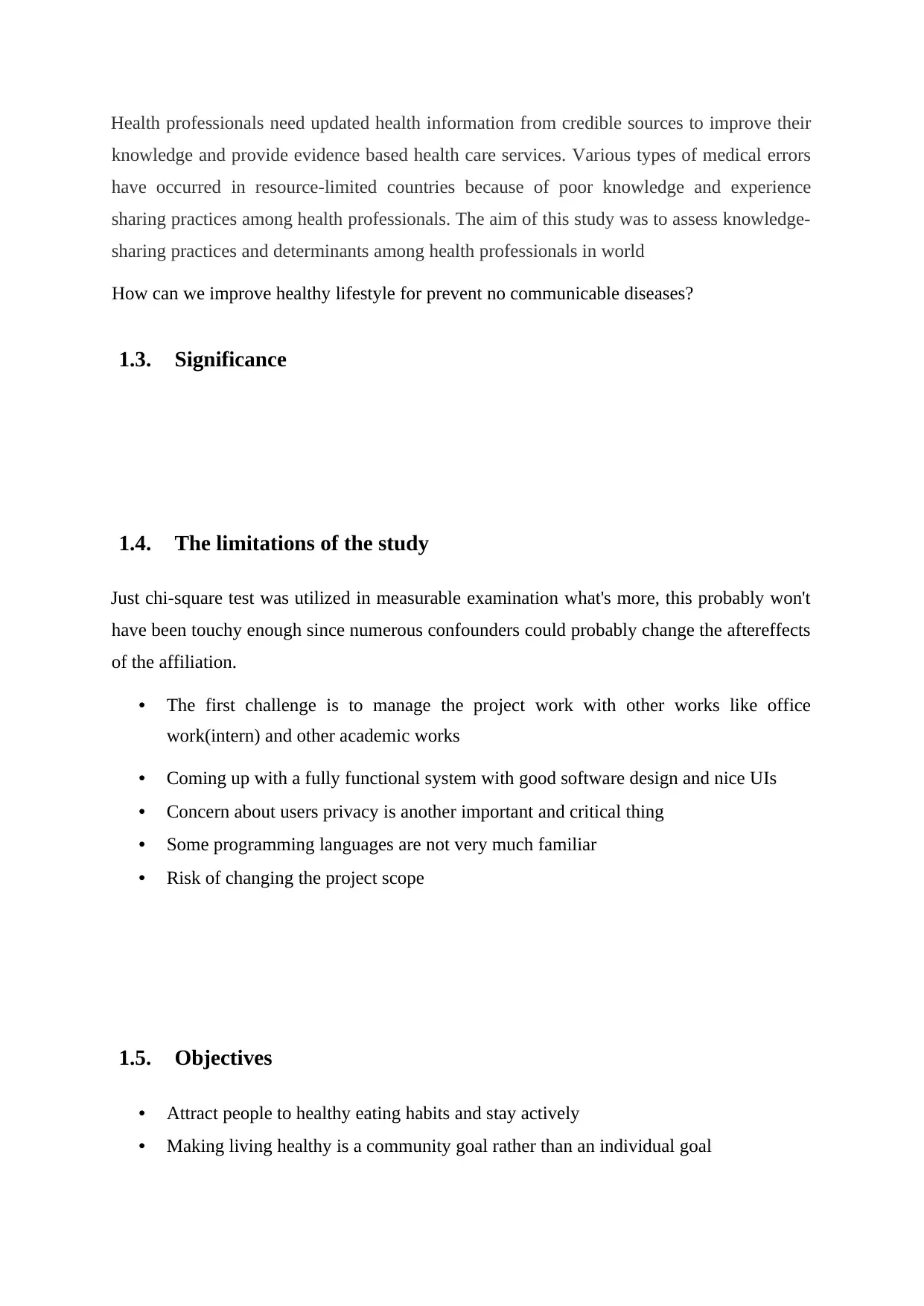
Health professionals need updated health information from credible sources to improve their
knowledge and provide evidence based health care services. Various types of medical errors
have occurred in resource-limited countries because of poor knowledge and experience
sharing practices among health professionals. The aim of this study was to assess knowledge-
sharing practices and determinants among health professionals in world
How can we improve healthy lifestyle for prevent no communicable diseases?
1.3. Significance
1.4. The limitations of the study
Just chi-square test was utilized in measurable examination what's more, this probably won't
have been touchy enough since numerous confounders could probably change the aftereffects
of the affiliation.
• The first challenge is to manage the project work with other works like office
work(intern) and other academic works
• Coming up with a fully functional system with good software design and nice UIs
• Concern about users privacy is another important and critical thing
• Some programming languages are not very much familiar
• Risk of changing the project scope
1.5. Objectives
• Attract people to healthy eating habits and stay actively
• Making living healthy is a community goal rather than an individual goal
knowledge and provide evidence based health care services. Various types of medical errors
have occurred in resource-limited countries because of poor knowledge and experience
sharing practices among health professionals. The aim of this study was to assess knowledge-
sharing practices and determinants among health professionals in world
How can we improve healthy lifestyle for prevent no communicable diseases?
1.3. Significance
1.4. The limitations of the study
Just chi-square test was utilized in measurable examination what's more, this probably won't
have been touchy enough since numerous confounders could probably change the aftereffects
of the affiliation.
• The first challenge is to manage the project work with other works like office
work(intern) and other academic works
• Coming up with a fully functional system with good software design and nice UIs
• Concern about users privacy is another important and critical thing
• Some programming languages are not very much familiar
• Risk of changing the project scope
1.5. Objectives
• Attract people to healthy eating habits and stay actively
• Making living healthy is a community goal rather than an individual goal
⊘ This is a preview!⊘
Do you want full access?
Subscribe today to unlock all pages.

Trusted by 1+ million students worldwide
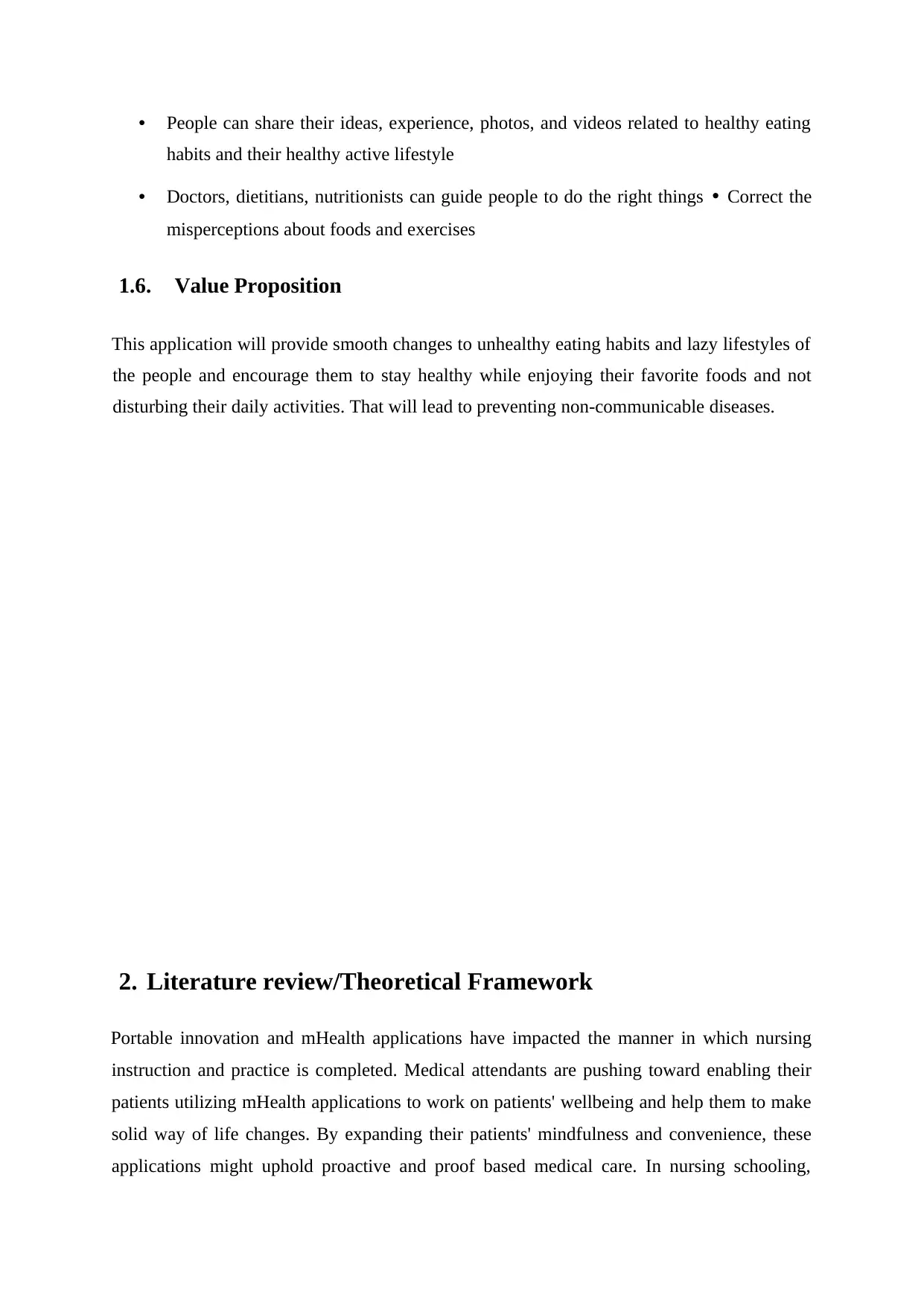
• People can share their ideas, experience, photos, and videos related to healthy eating
habits and their healthy active lifestyle
• Doctors, dietitians, nutritionists can guide people to do the right things • Correct the
misperceptions about foods and exercises
1.6. Value Proposition
This application will provide smooth changes to unhealthy eating habits and lazy lifestyles of
the people and encourage them to stay healthy while enjoying their favorite foods and not
disturbing their daily activities. That will lead to preventing non-communicable diseases.
2. Literature review/Theoretical Framework
Portable innovation and mHealth applications have impacted the manner in which nursing
instruction and practice is completed. Medical attendants are pushing toward enabling their
patients utilizing mHealth applications to work on patients' wellbeing and help them to make
solid way of life changes. By expanding their patients' mindfulness and convenience, these
applications might uphold proactive and proof based medical care. In nursing schooling,
habits and their healthy active lifestyle
• Doctors, dietitians, nutritionists can guide people to do the right things • Correct the
misperceptions about foods and exercises
1.6. Value Proposition
This application will provide smooth changes to unhealthy eating habits and lazy lifestyles of
the people and encourage them to stay healthy while enjoying their favorite foods and not
disturbing their daily activities. That will lead to preventing non-communicable diseases.
2. Literature review/Theoretical Framework
Portable innovation and mHealth applications have impacted the manner in which nursing
instruction and practice is completed. Medical attendants are pushing toward enabling their
patients utilizing mHealth applications to work on patients' wellbeing and help them to make
solid way of life changes. By expanding their patients' mindfulness and convenience, these
applications might uphold proactive and proof based medical care. In nursing schooling,
Paraphrase This Document
Need a fresh take? Get an instant paraphrase of this document with our AI Paraphraser
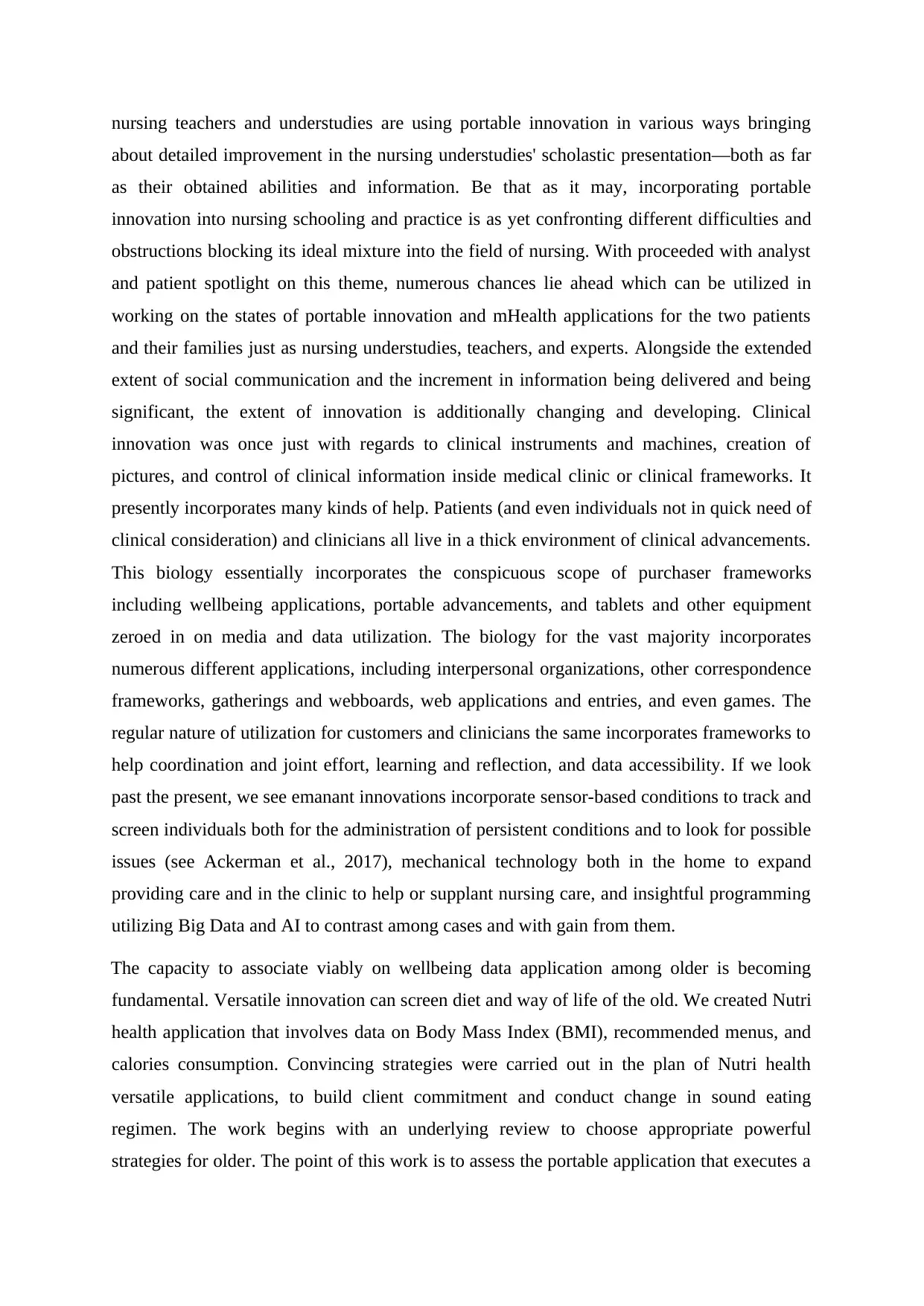
nursing teachers and understudies are using portable innovation in various ways bringing
about detailed improvement in the nursing understudies' scholastic presentation—both as far
as their obtained abilities and information. Be that as it may, incorporating portable
innovation into nursing schooling and practice is as yet confronting different difficulties and
obstructions blocking its ideal mixture into the field of nursing. With proceeded with analyst
and patient spotlight on this theme, numerous chances lie ahead which can be utilized in
working on the states of portable innovation and mHealth applications for the two patients
and their families just as nursing understudies, teachers, and experts. Alongside the extended
extent of social communication and the increment in information being delivered and being
significant, the extent of innovation is additionally changing and developing. Clinical
innovation was once just with regards to clinical instruments and machines, creation of
pictures, and control of clinical information inside medical clinic or clinical frameworks. It
presently incorporates many kinds of help. Patients (and even individuals not in quick need of
clinical consideration) and clinicians all live in a thick environment of clinical advancements.
This biology essentially incorporates the conspicuous scope of purchaser frameworks
including wellbeing applications, portable advancements, and tablets and other equipment
zeroed in on media and data utilization. The biology for the vast majority incorporates
numerous different applications, including interpersonal organizations, other correspondence
frameworks, gatherings and webboards, web applications and entries, and even games. The
regular nature of utilization for customers and clinicians the same incorporates frameworks to
help coordination and joint effort, learning and reflection, and data accessibility. If we look
past the present, we see emanant innovations incorporate sensor-based conditions to track and
screen individuals both for the administration of persistent conditions and to look for possible
issues (see Ackerman et al., 2017), mechanical technology both in the home to expand
providing care and in the clinic to help or supplant nursing care, and insightful programming
utilizing Big Data and AI to contrast among cases and with gain from them.
The capacity to associate viably on wellbeing data application among older is becoming
fundamental. Versatile innovation can screen diet and way of life of the old. We created Nutri
health application that involves data on Body Mass Index (BMI), recommended menus, and
calories consumption. Convincing strategies were carried out in the plan of Nutri health
versatile applications, to build client commitment and conduct change in sound eating
regimen. The work begins with an underlying review to choose appropriate powerful
strategies for older. The point of this work is to assess the portable application that executes a
about detailed improvement in the nursing understudies' scholastic presentation—both as far
as their obtained abilities and information. Be that as it may, incorporating portable
innovation into nursing schooling and practice is as yet confronting different difficulties and
obstructions blocking its ideal mixture into the field of nursing. With proceeded with analyst
and patient spotlight on this theme, numerous chances lie ahead which can be utilized in
working on the states of portable innovation and mHealth applications for the two patients
and their families just as nursing understudies, teachers, and experts. Alongside the extended
extent of social communication and the increment in information being delivered and being
significant, the extent of innovation is additionally changing and developing. Clinical
innovation was once just with regards to clinical instruments and machines, creation of
pictures, and control of clinical information inside medical clinic or clinical frameworks. It
presently incorporates many kinds of help. Patients (and even individuals not in quick need of
clinical consideration) and clinicians all live in a thick environment of clinical advancements.
This biology essentially incorporates the conspicuous scope of purchaser frameworks
including wellbeing applications, portable advancements, and tablets and other equipment
zeroed in on media and data utilization. The biology for the vast majority incorporates
numerous different applications, including interpersonal organizations, other correspondence
frameworks, gatherings and webboards, web applications and entries, and even games. The
regular nature of utilization for customers and clinicians the same incorporates frameworks to
help coordination and joint effort, learning and reflection, and data accessibility. If we look
past the present, we see emanant innovations incorporate sensor-based conditions to track and
screen individuals both for the administration of persistent conditions and to look for possible
issues (see Ackerman et al., 2017), mechanical technology both in the home to expand
providing care and in the clinic to help or supplant nursing care, and insightful programming
utilizing Big Data and AI to contrast among cases and with gain from them.
The capacity to associate viably on wellbeing data application among older is becoming
fundamental. Versatile innovation can screen diet and way of life of the old. We created Nutri
health application that involves data on Body Mass Index (BMI), recommended menus, and
calories consumption. Convincing strategies were carried out in the plan of Nutri health
versatile applications, to build client commitment and conduct change in sound eating
regimen. The work begins with an underlying review to choose appropriate powerful
strategies for older. The point of this work is to assess the portable application that executes a
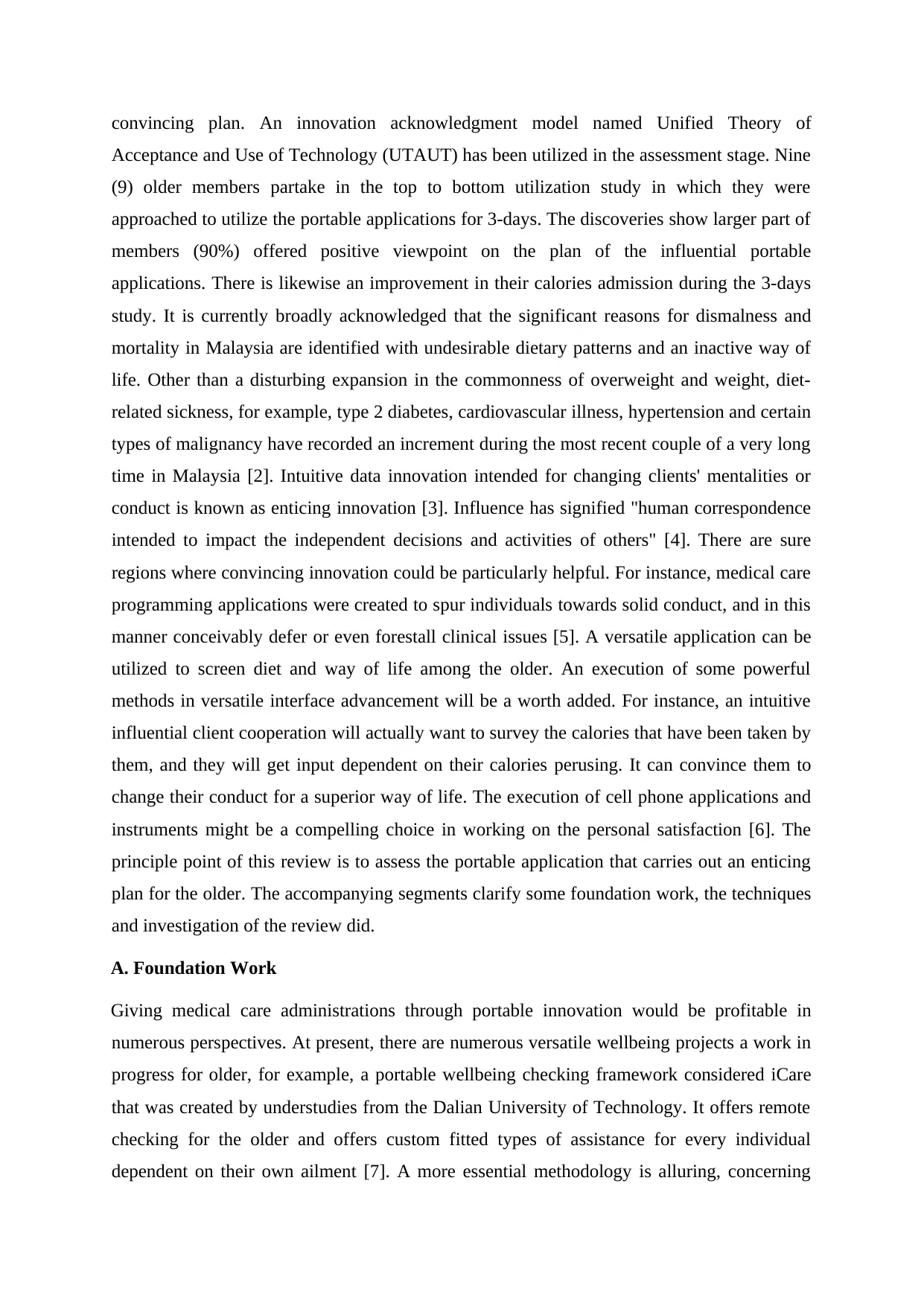
convincing plan. An innovation acknowledgment model named Unified Theory of
Acceptance and Use of Technology (UTAUT) has been utilized in the assessment stage. Nine
(9) older members partake in the top to bottom utilization study in which they were
approached to utilize the portable applications for 3-days. The discoveries show larger part of
members (90%) offered positive viewpoint on the plan of the influential portable
applications. There is likewise an improvement in their calories admission during the 3-days
study. It is currently broadly acknowledged that the significant reasons for dismalness and
mortality in Malaysia are identified with undesirable dietary patterns and an inactive way of
life. Other than a disturbing expansion in the commonness of overweight and weight, diet-
related sickness, for example, type 2 diabetes, cardiovascular illness, hypertension and certain
types of malignancy have recorded an increment during the most recent couple of a very long
time in Malaysia [2]. Intuitive data innovation intended for changing clients' mentalities or
conduct is known as enticing innovation [3]. Influence has signified "human correspondence
intended to impact the independent decisions and activities of others" [4]. There are sure
regions where convincing innovation could be particularly helpful. For instance, medical care
programming applications were created to spur individuals towards solid conduct, and in this
manner conceivably defer or even forestall clinical issues [5]. A versatile application can be
utilized to screen diet and way of life among the older. An execution of some powerful
methods in versatile interface advancement will be a worth added. For instance, an intuitive
influential client cooperation will actually want to survey the calories that have been taken by
them, and they will get input dependent on their calories perusing. It can convince them to
change their conduct for a superior way of life. The execution of cell phone applications and
instruments might be a compelling choice in working on the personal satisfaction [6]. The
principle point of this review is to assess the portable application that carries out an enticing
plan for the older. The accompanying segments clarify some foundation work, the techniques
and investigation of the review did.
A. Foundation Work
Giving medical care administrations through portable innovation would be profitable in
numerous perspectives. At present, there are numerous versatile wellbeing projects a work in
progress for older, for example, a portable wellbeing checking framework considered iCare
that was created by understudies from the Dalian University of Technology. It offers remote
checking for the older and offers custom fitted types of assistance for every individual
dependent on their own ailment [7]. A more essential methodology is alluring, concerning
Acceptance and Use of Technology (UTAUT) has been utilized in the assessment stage. Nine
(9) older members partake in the top to bottom utilization study in which they were
approached to utilize the portable applications for 3-days. The discoveries show larger part of
members (90%) offered positive viewpoint on the plan of the influential portable
applications. There is likewise an improvement in their calories admission during the 3-days
study. It is currently broadly acknowledged that the significant reasons for dismalness and
mortality in Malaysia are identified with undesirable dietary patterns and an inactive way of
life. Other than a disturbing expansion in the commonness of overweight and weight, diet-
related sickness, for example, type 2 diabetes, cardiovascular illness, hypertension and certain
types of malignancy have recorded an increment during the most recent couple of a very long
time in Malaysia [2]. Intuitive data innovation intended for changing clients' mentalities or
conduct is known as enticing innovation [3]. Influence has signified "human correspondence
intended to impact the independent decisions and activities of others" [4]. There are sure
regions where convincing innovation could be particularly helpful. For instance, medical care
programming applications were created to spur individuals towards solid conduct, and in this
manner conceivably defer or even forestall clinical issues [5]. A versatile application can be
utilized to screen diet and way of life among the older. An execution of some powerful
methods in versatile interface advancement will be a worth added. For instance, an intuitive
influential client cooperation will actually want to survey the calories that have been taken by
them, and they will get input dependent on their calories perusing. It can convince them to
change their conduct for a superior way of life. The execution of cell phone applications and
instruments might be a compelling choice in working on the personal satisfaction [6]. The
principle point of this review is to assess the portable application that carries out an enticing
plan for the older. The accompanying segments clarify some foundation work, the techniques
and investigation of the review did.
A. Foundation Work
Giving medical care administrations through portable innovation would be profitable in
numerous perspectives. At present, there are numerous versatile wellbeing projects a work in
progress for older, for example, a portable wellbeing checking framework considered iCare
that was created by understudies from the Dalian University of Technology. It offers remote
checking for the older and offers custom fitted types of assistance for every individual
dependent on their own ailment [7]. A more essential methodology is alluring, concerning
⊘ This is a preview!⊘
Do you want full access?
Subscribe today to unlock all pages.

Trusted by 1+ million students worldwide
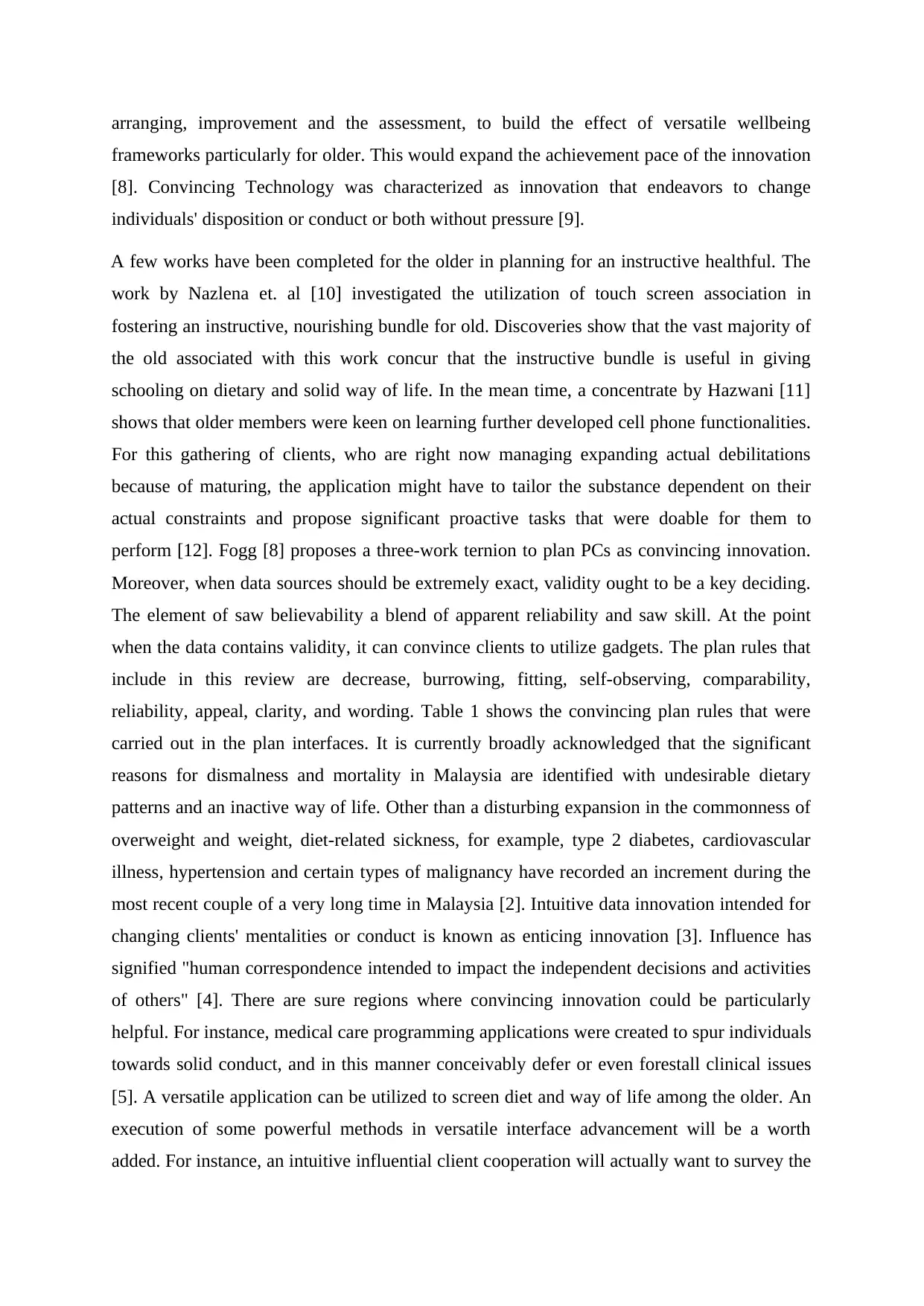
arranging, improvement and the assessment, to build the effect of versatile wellbeing
frameworks particularly for older. This would expand the achievement pace of the innovation
[8]. Convincing Technology was characterized as innovation that endeavors to change
individuals' disposition or conduct or both without pressure [9].
A few works have been completed for the older in planning for an instructive healthful. The
work by Nazlena et. al [10] investigated the utilization of touch screen association in
fostering an instructive, nourishing bundle for old. Discoveries show that the vast majority of
the old associated with this work concur that the instructive bundle is useful in giving
schooling on dietary and solid way of life. In the mean time, a concentrate by Hazwani [11]
shows that older members were keen on learning further developed cell phone functionalities.
For this gathering of clients, who are right now managing expanding actual debilitations
because of maturing, the application might have to tailor the substance dependent on their
actual constraints and propose significant proactive tasks that were doable for them to
perform [12]. Fogg [8] proposes a three-work ternion to plan PCs as convincing innovation.
Moreover, when data sources should be extremely exact, validity ought to be a key deciding.
The element of saw believability a blend of apparent reliability and saw skill. At the point
when the data contains validity, it can convince clients to utilize gadgets. The plan rules that
include in this review are decrease, burrowing, fitting, self-observing, comparability,
reliability, appeal, clarity, and wording. Table 1 shows the convincing plan rules that were
carried out in the plan interfaces. It is currently broadly acknowledged that the significant
reasons for dismalness and mortality in Malaysia are identified with undesirable dietary
patterns and an inactive way of life. Other than a disturbing expansion in the commonness of
overweight and weight, diet-related sickness, for example, type 2 diabetes, cardiovascular
illness, hypertension and certain types of malignancy have recorded an increment during the
most recent couple of a very long time in Malaysia [2]. Intuitive data innovation intended for
changing clients' mentalities or conduct is known as enticing innovation [3]. Influence has
signified "human correspondence intended to impact the independent decisions and activities
of others" [4]. There are sure regions where convincing innovation could be particularly
helpful. For instance, medical care programming applications were created to spur individuals
towards solid conduct, and in this manner conceivably defer or even forestall clinical issues
[5]. A versatile application can be utilized to screen diet and way of life among the older. An
execution of some powerful methods in versatile interface advancement will be a worth
added. For instance, an intuitive influential client cooperation will actually want to survey the
frameworks particularly for older. This would expand the achievement pace of the innovation
[8]. Convincing Technology was characterized as innovation that endeavors to change
individuals' disposition or conduct or both without pressure [9].
A few works have been completed for the older in planning for an instructive healthful. The
work by Nazlena et. al [10] investigated the utilization of touch screen association in
fostering an instructive, nourishing bundle for old. Discoveries show that the vast majority of
the old associated with this work concur that the instructive bundle is useful in giving
schooling on dietary and solid way of life. In the mean time, a concentrate by Hazwani [11]
shows that older members were keen on learning further developed cell phone functionalities.
For this gathering of clients, who are right now managing expanding actual debilitations
because of maturing, the application might have to tailor the substance dependent on their
actual constraints and propose significant proactive tasks that were doable for them to
perform [12]. Fogg [8] proposes a three-work ternion to plan PCs as convincing innovation.
Moreover, when data sources should be extremely exact, validity ought to be a key deciding.
The element of saw believability a blend of apparent reliability and saw skill. At the point
when the data contains validity, it can convince clients to utilize gadgets. The plan rules that
include in this review are decrease, burrowing, fitting, self-observing, comparability,
reliability, appeal, clarity, and wording. Table 1 shows the convincing plan rules that were
carried out in the plan interfaces. It is currently broadly acknowledged that the significant
reasons for dismalness and mortality in Malaysia are identified with undesirable dietary
patterns and an inactive way of life. Other than a disturbing expansion in the commonness of
overweight and weight, diet-related sickness, for example, type 2 diabetes, cardiovascular
illness, hypertension and certain types of malignancy have recorded an increment during the
most recent couple of a very long time in Malaysia [2]. Intuitive data innovation intended for
changing clients' mentalities or conduct is known as enticing innovation [3]. Influence has
signified "human correspondence intended to impact the independent decisions and activities
of others" [4]. There are sure regions where convincing innovation could be particularly
helpful. For instance, medical care programming applications were created to spur individuals
towards solid conduct, and in this manner conceivably defer or even forestall clinical issues
[5]. A versatile application can be utilized to screen diet and way of life among the older. An
execution of some powerful methods in versatile interface advancement will be a worth
added. For instance, an intuitive influential client cooperation will actually want to survey the
Paraphrase This Document
Need a fresh take? Get an instant paraphrase of this document with our AI Paraphraser
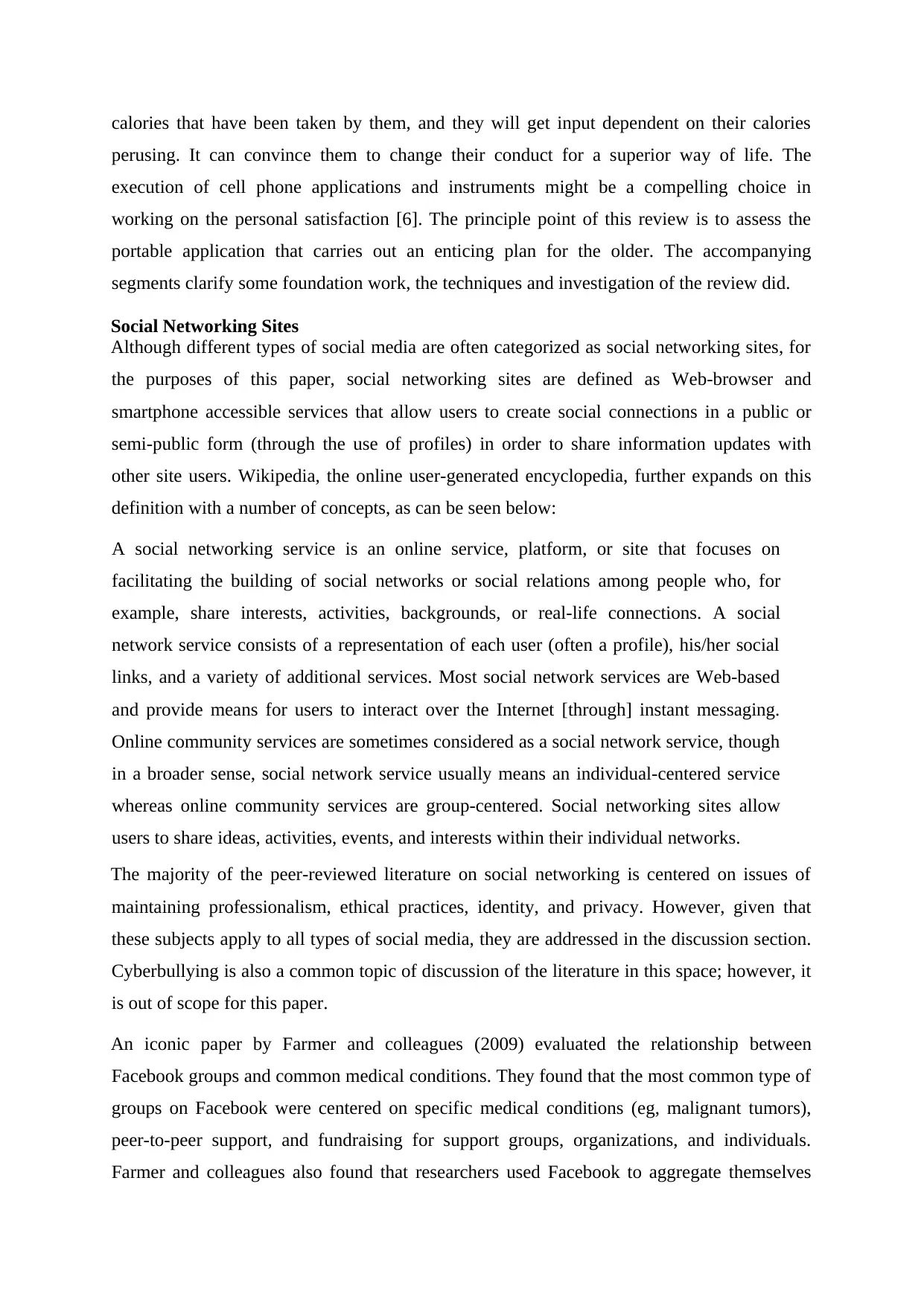
calories that have been taken by them, and they will get input dependent on their calories
perusing. It can convince them to change their conduct for a superior way of life. The
execution of cell phone applications and instruments might be a compelling choice in
working on the personal satisfaction [6]. The principle point of this review is to assess the
portable application that carries out an enticing plan for the older. The accompanying
segments clarify some foundation work, the techniques and investigation of the review did.
Social Networking Sites
Although different types of social media are often categorized as social networking sites, for
the purposes of this paper, social networking sites are defined as Web-browser and
smartphone accessible services that allow users to create social connections in a public or
semi-public form (through the use of profiles) in order to share information updates with
other site users. Wikipedia, the online user-generated encyclopedia, further expands on this
definition with a number of concepts, as can be seen below:
A social networking service is an online service, platform, or site that focuses on
facilitating the building of social networks or social relations among people who, for
example, share interests, activities, backgrounds, or real-life connections. A social
network service consists of a representation of each user (often a profile), his/her social
links, and a variety of additional services. Most social network services are Web-based
and provide means for users to interact over the Internet [through] instant messaging.
Online community services are sometimes considered as a social network service, though
in a broader sense, social network service usually means an individual-centered service
whereas online community services are group-centered. Social networking sites allow
users to share ideas, activities, events, and interests within their individual networks.
The majority of the peer-reviewed literature on social networking is centered on issues of
maintaining professionalism, ethical practices, identity, and privacy. However, given that
these subjects apply to all types of social media, they are addressed in the discussion section.
Cyberbullying is also a common topic of discussion of the literature in this space; however, it
is out of scope for this paper.
An iconic paper by Farmer and colleagues (2009) evaluated the relationship between
Facebook groups and common medical conditions. They found that the most common type of
groups on Facebook were centered on specific medical conditions (eg, malignant tumors),
peer-to-peer support, and fundraising for support groups, organizations, and individuals.
Farmer and colleagues also found that researchers used Facebook to aggregate themselves
perusing. It can convince them to change their conduct for a superior way of life. The
execution of cell phone applications and instruments might be a compelling choice in
working on the personal satisfaction [6]. The principle point of this review is to assess the
portable application that carries out an enticing plan for the older. The accompanying
segments clarify some foundation work, the techniques and investigation of the review did.
Social Networking Sites
Although different types of social media are often categorized as social networking sites, for
the purposes of this paper, social networking sites are defined as Web-browser and
smartphone accessible services that allow users to create social connections in a public or
semi-public form (through the use of profiles) in order to share information updates with
other site users. Wikipedia, the online user-generated encyclopedia, further expands on this
definition with a number of concepts, as can be seen below:
A social networking service is an online service, platform, or site that focuses on
facilitating the building of social networks or social relations among people who, for
example, share interests, activities, backgrounds, or real-life connections. A social
network service consists of a representation of each user (often a profile), his/her social
links, and a variety of additional services. Most social network services are Web-based
and provide means for users to interact over the Internet [through] instant messaging.
Online community services are sometimes considered as a social network service, though
in a broader sense, social network service usually means an individual-centered service
whereas online community services are group-centered. Social networking sites allow
users to share ideas, activities, events, and interests within their individual networks.
The majority of the peer-reviewed literature on social networking is centered on issues of
maintaining professionalism, ethical practices, identity, and privacy. However, given that
these subjects apply to all types of social media, they are addressed in the discussion section.
Cyberbullying is also a common topic of discussion of the literature in this space; however, it
is out of scope for this paper.
An iconic paper by Farmer and colleagues (2009) evaluated the relationship between
Facebook groups and common medical conditions. They found that the most common type of
groups on Facebook were centered on specific medical conditions (eg, malignant tumors),
peer-to-peer support, and fundraising for support groups, organizations, and individuals.
Farmer and colleagues also found that researchers used Facebook to aggregate themselves
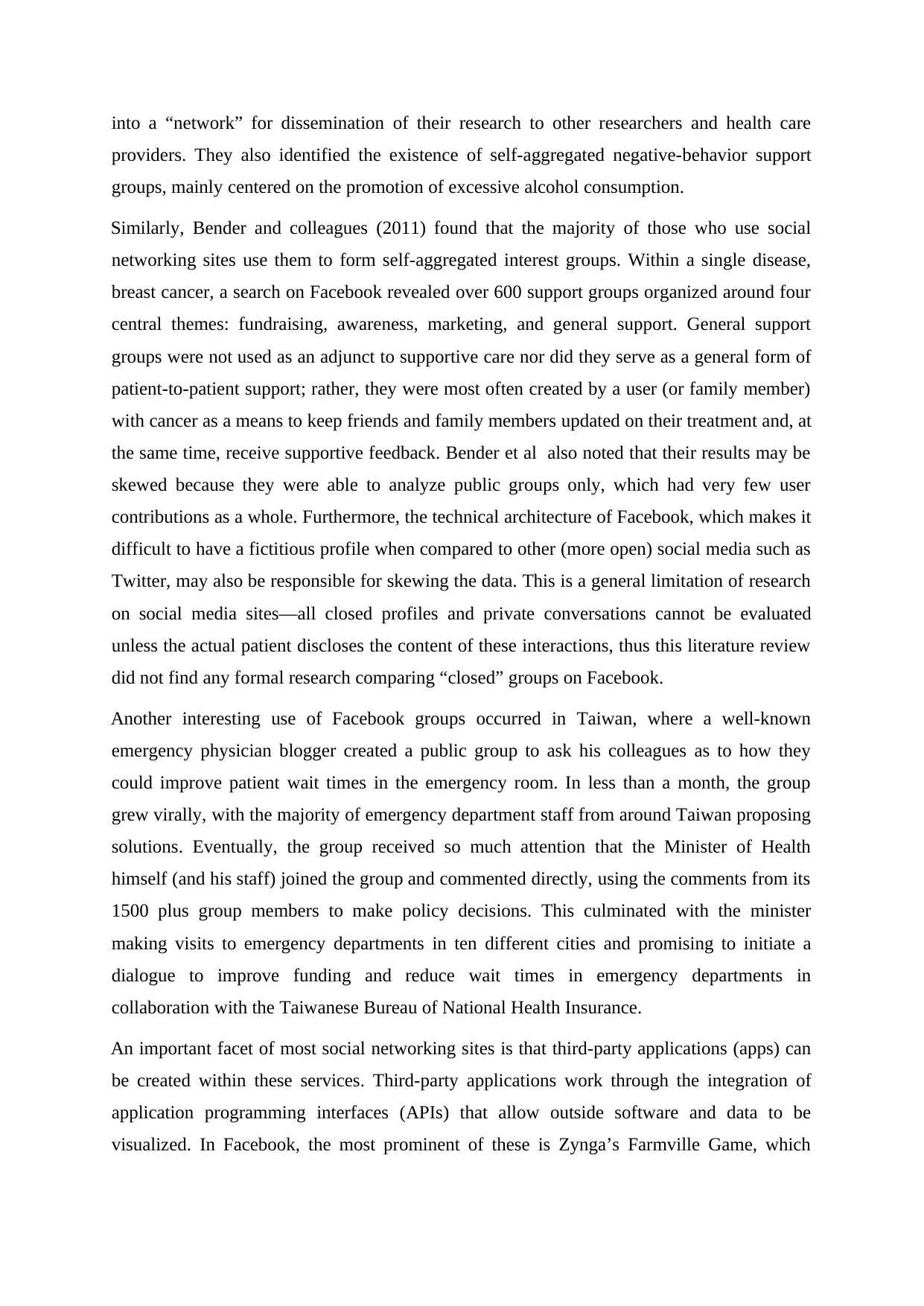
into a “network” for dissemination of their research to other researchers and health care
providers. They also identified the existence of self-aggregated negative-behavior support
groups, mainly centered on the promotion of excessive alcohol consumption.
Similarly, Bender and colleagues (2011) found that the majority of those who use social
networking sites use them to form self-aggregated interest groups. Within a single disease,
breast cancer, a search on Facebook revealed over 600 support groups organized around four
central themes: fundraising, awareness, marketing, and general support. General support
groups were not used as an adjunct to supportive care nor did they serve as a general form of
patient-to-patient support; rather, they were most often created by a user (or family member)
with cancer as a means to keep friends and family members updated on their treatment and, at
the same time, receive supportive feedback. Bender et al also noted that their results may be
skewed because they were able to analyze public groups only, which had very few user
contributions as a whole. Furthermore, the technical architecture of Facebook, which makes it
difficult to have a fictitious profile when compared to other (more open) social media such as
Twitter, may also be responsible for skewing the data. This is a general limitation of research
on social media sites—all closed profiles and private conversations cannot be evaluated
unless the actual patient discloses the content of these interactions, thus this literature review
did not find any formal research comparing “closed” groups on Facebook.
Another interesting use of Facebook groups occurred in Taiwan, where a well-known
emergency physician blogger created a public group to ask his colleagues as to how they
could improve patient wait times in the emergency room. In less than a month, the group
grew virally, with the majority of emergency department staff from around Taiwan proposing
solutions. Eventually, the group received so much attention that the Minister of Health
himself (and his staff) joined the group and commented directly, using the comments from its
1500 plus group members to make policy decisions. This culminated with the minister
making visits to emergency departments in ten different cities and promising to initiate a
dialogue to improve funding and reduce wait times in emergency departments in
collaboration with the Taiwanese Bureau of National Health Insurance.
An important facet of most social networking sites is that third-party applications (apps) can
be created within these services. Third-party applications work through the integration of
application programming interfaces (APIs) that allow outside software and data to be
visualized. In Facebook, the most prominent of these is Zynga’s Farmville Game, which
providers. They also identified the existence of self-aggregated negative-behavior support
groups, mainly centered on the promotion of excessive alcohol consumption.
Similarly, Bender and colleagues (2011) found that the majority of those who use social
networking sites use them to form self-aggregated interest groups. Within a single disease,
breast cancer, a search on Facebook revealed over 600 support groups organized around four
central themes: fundraising, awareness, marketing, and general support. General support
groups were not used as an adjunct to supportive care nor did they serve as a general form of
patient-to-patient support; rather, they were most often created by a user (or family member)
with cancer as a means to keep friends and family members updated on their treatment and, at
the same time, receive supportive feedback. Bender et al also noted that their results may be
skewed because they were able to analyze public groups only, which had very few user
contributions as a whole. Furthermore, the technical architecture of Facebook, which makes it
difficult to have a fictitious profile when compared to other (more open) social media such as
Twitter, may also be responsible for skewing the data. This is a general limitation of research
on social media sites—all closed profiles and private conversations cannot be evaluated
unless the actual patient discloses the content of these interactions, thus this literature review
did not find any formal research comparing “closed” groups on Facebook.
Another interesting use of Facebook groups occurred in Taiwan, where a well-known
emergency physician blogger created a public group to ask his colleagues as to how they
could improve patient wait times in the emergency room. In less than a month, the group
grew virally, with the majority of emergency department staff from around Taiwan proposing
solutions. Eventually, the group received so much attention that the Minister of Health
himself (and his staff) joined the group and commented directly, using the comments from its
1500 plus group members to make policy decisions. This culminated with the minister
making visits to emergency departments in ten different cities and promising to initiate a
dialogue to improve funding and reduce wait times in emergency departments in
collaboration with the Taiwanese Bureau of National Health Insurance.
An important facet of most social networking sites is that third-party applications (apps) can
be created within these services. Third-party applications work through the integration of
application programming interfaces (APIs) that allow outside software and data to be
visualized. In Facebook, the most prominent of these is Zynga’s Farmville Game, which
⊘ This is a preview!⊘
Do you want full access?
Subscribe today to unlock all pages.

Trusted by 1+ million students worldwide
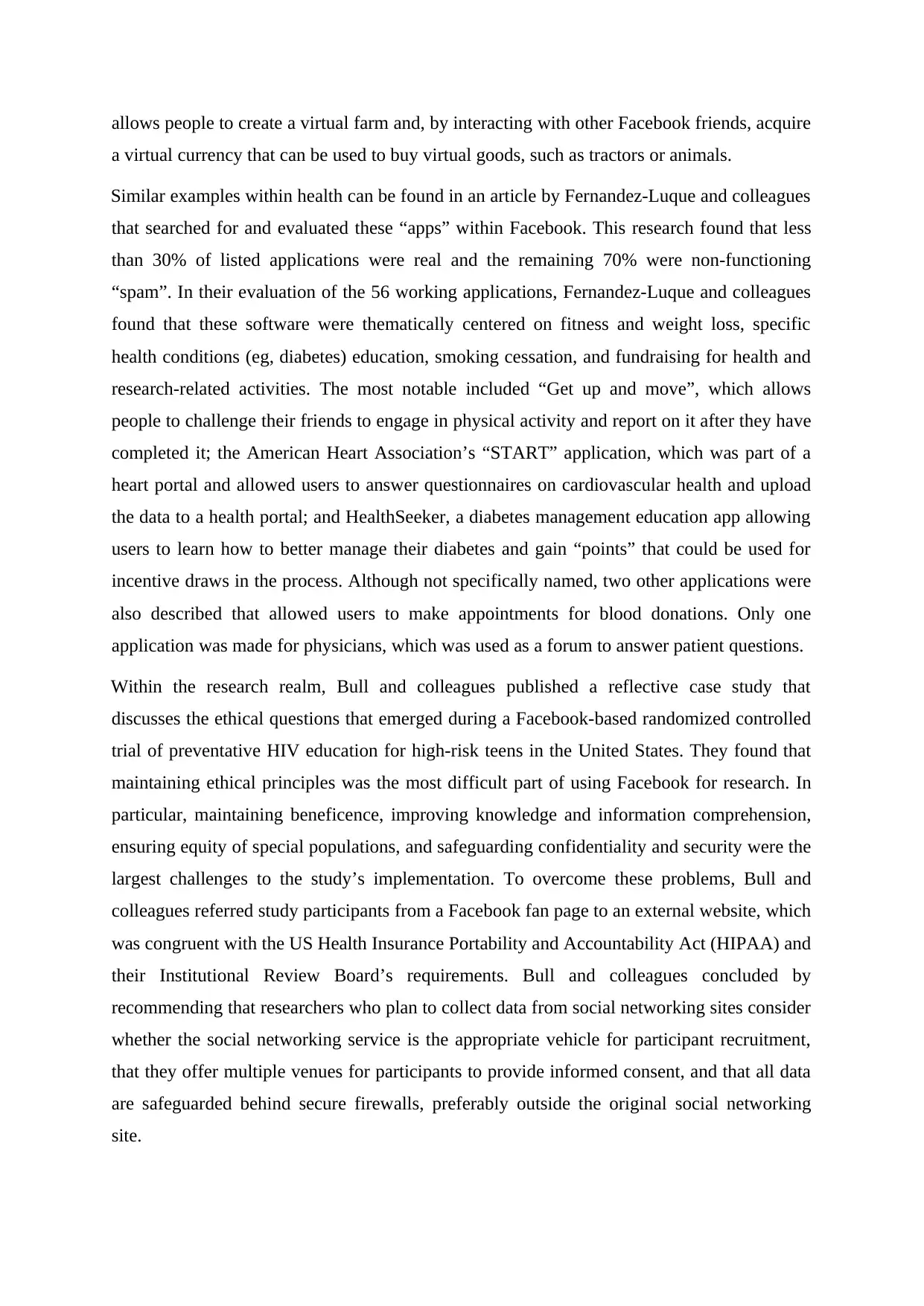
allows people to create a virtual farm and, by interacting with other Facebook friends, acquire
a virtual currency that can be used to buy virtual goods, such as tractors or animals.
Similar examples within health can be found in an article by Fernandez-Luque and colleagues
that searched for and evaluated these “apps” within Facebook. This research found that less
than 30% of listed applications were real and the remaining 70% were non-functioning
“spam”. In their evaluation of the 56 working applications, Fernandez-Luque and colleagues
found that these software were thematically centered on fitness and weight loss, specific
health conditions (eg, diabetes) education, smoking cessation, and fundraising for health and
research-related activities. The most notable included “Get up and move”, which allows
people to challenge their friends to engage in physical activity and report on it after they have
completed it; the American Heart Association’s “START” application, which was part of a
heart portal and allowed users to answer questionnaires on cardiovascular health and upload
the data to a health portal; and HealthSeeker, a diabetes management education app allowing
users to learn how to better manage their diabetes and gain “points” that could be used for
incentive draws in the process. Although not specifically named, two other applications were
also described that allowed users to make appointments for blood donations. Only one
application was made for physicians, which was used as a forum to answer patient questions.
Within the research realm, Bull and colleagues published a reflective case study that
discusses the ethical questions that emerged during a Facebook-based randomized controlled
trial of preventative HIV education for high-risk teens in the United States. They found that
maintaining ethical principles was the most difficult part of using Facebook for research. In
particular, maintaining beneficence, improving knowledge and information comprehension,
ensuring equity of special populations, and safeguarding confidentiality and security were the
largest challenges to the study’s implementation. To overcome these problems, Bull and
colleagues referred study participants from a Facebook fan page to an external website, which
was congruent with the US Health Insurance Portability and Accountability Act (HIPAA) and
their Institutional Review Board’s requirements. Bull and colleagues concluded by
recommending that researchers who plan to collect data from social networking sites consider
whether the social networking service is the appropriate vehicle for participant recruitment,
that they offer multiple venues for participants to provide informed consent, and that all data
are safeguarded behind secure firewalls, preferably outside the original social networking
site.
a virtual currency that can be used to buy virtual goods, such as tractors or animals.
Similar examples within health can be found in an article by Fernandez-Luque and colleagues
that searched for and evaluated these “apps” within Facebook. This research found that less
than 30% of listed applications were real and the remaining 70% were non-functioning
“spam”. In their evaluation of the 56 working applications, Fernandez-Luque and colleagues
found that these software were thematically centered on fitness and weight loss, specific
health conditions (eg, diabetes) education, smoking cessation, and fundraising for health and
research-related activities. The most notable included “Get up and move”, which allows
people to challenge their friends to engage in physical activity and report on it after they have
completed it; the American Heart Association’s “START” application, which was part of a
heart portal and allowed users to answer questionnaires on cardiovascular health and upload
the data to a health portal; and HealthSeeker, a diabetes management education app allowing
users to learn how to better manage their diabetes and gain “points” that could be used for
incentive draws in the process. Although not specifically named, two other applications were
also described that allowed users to make appointments for blood donations. Only one
application was made for physicians, which was used as a forum to answer patient questions.
Within the research realm, Bull and colleagues published a reflective case study that
discusses the ethical questions that emerged during a Facebook-based randomized controlled
trial of preventative HIV education for high-risk teens in the United States. They found that
maintaining ethical principles was the most difficult part of using Facebook for research. In
particular, maintaining beneficence, improving knowledge and information comprehension,
ensuring equity of special populations, and safeguarding confidentiality and security were the
largest challenges to the study’s implementation. To overcome these problems, Bull and
colleagues referred study participants from a Facebook fan page to an external website, which
was congruent with the US Health Insurance Portability and Accountability Act (HIPAA) and
their Institutional Review Board’s requirements. Bull and colleagues concluded by
recommending that researchers who plan to collect data from social networking sites consider
whether the social networking service is the appropriate vehicle for participant recruitment,
that they offer multiple venues for participants to provide informed consent, and that all data
are safeguarded behind secure firewalls, preferably outside the original social networking
site.
Paraphrase This Document
Need a fresh take? Get an instant paraphrase of this document with our AI Paraphraser
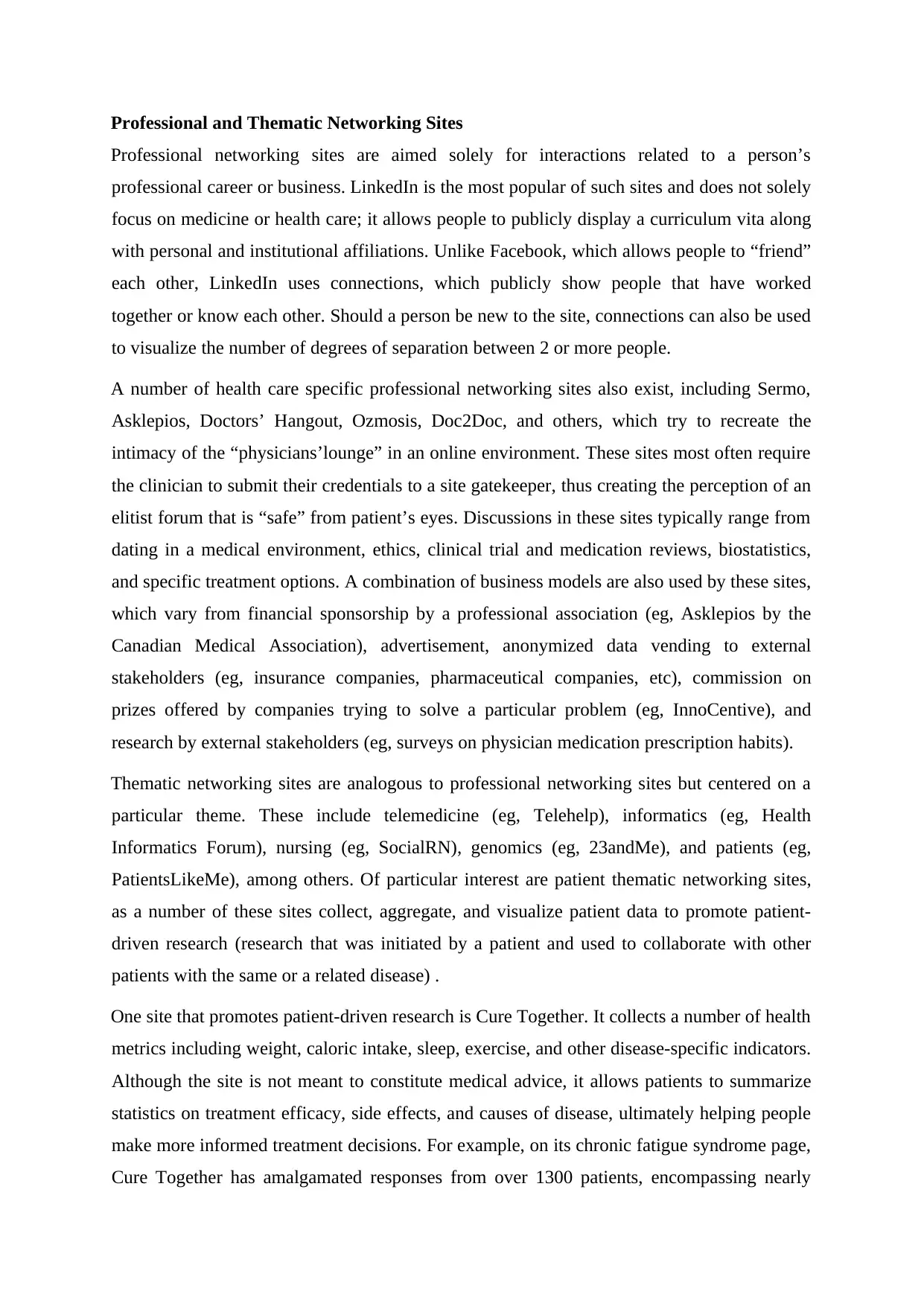
Professional and Thematic Networking Sites
Professional networking sites are aimed solely for interactions related to a person’s
professional career or business. LinkedIn is the most popular of such sites and does not solely
focus on medicine or health care; it allows people to publicly display a curriculum vita along
with personal and institutional affiliations. Unlike Facebook, which allows people to “friend”
each other, LinkedIn uses connections, which publicly show people that have worked
together or know each other. Should a person be new to the site, connections can also be used
to visualize the number of degrees of separation between 2 or more people.
A number of health care specific professional networking sites also exist, including Sermo,
Asklepios, Doctors’ Hangout, Ozmosis, Doc2Doc, and others, which try to recreate the
intimacy of the “physicians’lounge” in an online environment. These sites most often require
the clinician to submit their credentials to a site gatekeeper, thus creating the perception of an
elitist forum that is “safe” from patient’s eyes. Discussions in these sites typically range from
dating in a medical environment, ethics, clinical trial and medication reviews, biostatistics,
and specific treatment options. A combination of business models are also used by these sites,
which vary from financial sponsorship by a professional association (eg, Asklepios by the
Canadian Medical Association), advertisement, anonymized data vending to external
stakeholders (eg, insurance companies, pharmaceutical companies, etc), commission on
prizes offered by companies trying to solve a particular problem (eg, InnoCentive), and
research by external stakeholders (eg, surveys on physician medication prescription habits).
Thematic networking sites are analogous to professional networking sites but centered on a
particular theme. These include telemedicine (eg, Telehelp), informatics (eg, Health
Informatics Forum), nursing (eg, SocialRN), genomics (eg, 23andMe), and patients (eg,
PatientsLikeMe), among others. Of particular interest are patient thematic networking sites,
as a number of these sites collect, aggregate, and visualize patient data to promote patient-
driven research (research that was initiated by a patient and used to collaborate with other
patients with the same or a related disease) .
One site that promotes patient-driven research is Cure Together. It collects a number of health
metrics including weight, caloric intake, sleep, exercise, and other disease-specific indicators.
Although the site is not meant to constitute medical advice, it allows patients to summarize
statistics on treatment efficacy, side effects, and causes of disease, ultimately helping people
make more informed treatment decisions. For example, on its chronic fatigue syndrome page,
Cure Together has amalgamated responses from over 1300 patients, encompassing nearly
Professional networking sites are aimed solely for interactions related to a person’s
professional career or business. LinkedIn is the most popular of such sites and does not solely
focus on medicine or health care; it allows people to publicly display a curriculum vita along
with personal and institutional affiliations. Unlike Facebook, which allows people to “friend”
each other, LinkedIn uses connections, which publicly show people that have worked
together or know each other. Should a person be new to the site, connections can also be used
to visualize the number of degrees of separation between 2 or more people.
A number of health care specific professional networking sites also exist, including Sermo,
Asklepios, Doctors’ Hangout, Ozmosis, Doc2Doc, and others, which try to recreate the
intimacy of the “physicians’lounge” in an online environment. These sites most often require
the clinician to submit their credentials to a site gatekeeper, thus creating the perception of an
elitist forum that is “safe” from patient’s eyes. Discussions in these sites typically range from
dating in a medical environment, ethics, clinical trial and medication reviews, biostatistics,
and specific treatment options. A combination of business models are also used by these sites,
which vary from financial sponsorship by a professional association (eg, Asklepios by the
Canadian Medical Association), advertisement, anonymized data vending to external
stakeholders (eg, insurance companies, pharmaceutical companies, etc), commission on
prizes offered by companies trying to solve a particular problem (eg, InnoCentive), and
research by external stakeholders (eg, surveys on physician medication prescription habits).
Thematic networking sites are analogous to professional networking sites but centered on a
particular theme. These include telemedicine (eg, Telehelp), informatics (eg, Health
Informatics Forum), nursing (eg, SocialRN), genomics (eg, 23andMe), and patients (eg,
PatientsLikeMe), among others. Of particular interest are patient thematic networking sites,
as a number of these sites collect, aggregate, and visualize patient data to promote patient-
driven research (research that was initiated by a patient and used to collaborate with other
patients with the same or a related disease) .
One site that promotes patient-driven research is Cure Together. It collects a number of health
metrics including weight, caloric intake, sleep, exercise, and other disease-specific indicators.
Although the site is not meant to constitute medical advice, it allows patients to summarize
statistics on treatment efficacy, side effects, and causes of disease, ultimately helping people
make more informed treatment decisions. For example, on its chronic fatigue syndrome page,
Cure Together has amalgamated responses from over 1300 patients, encompassing nearly
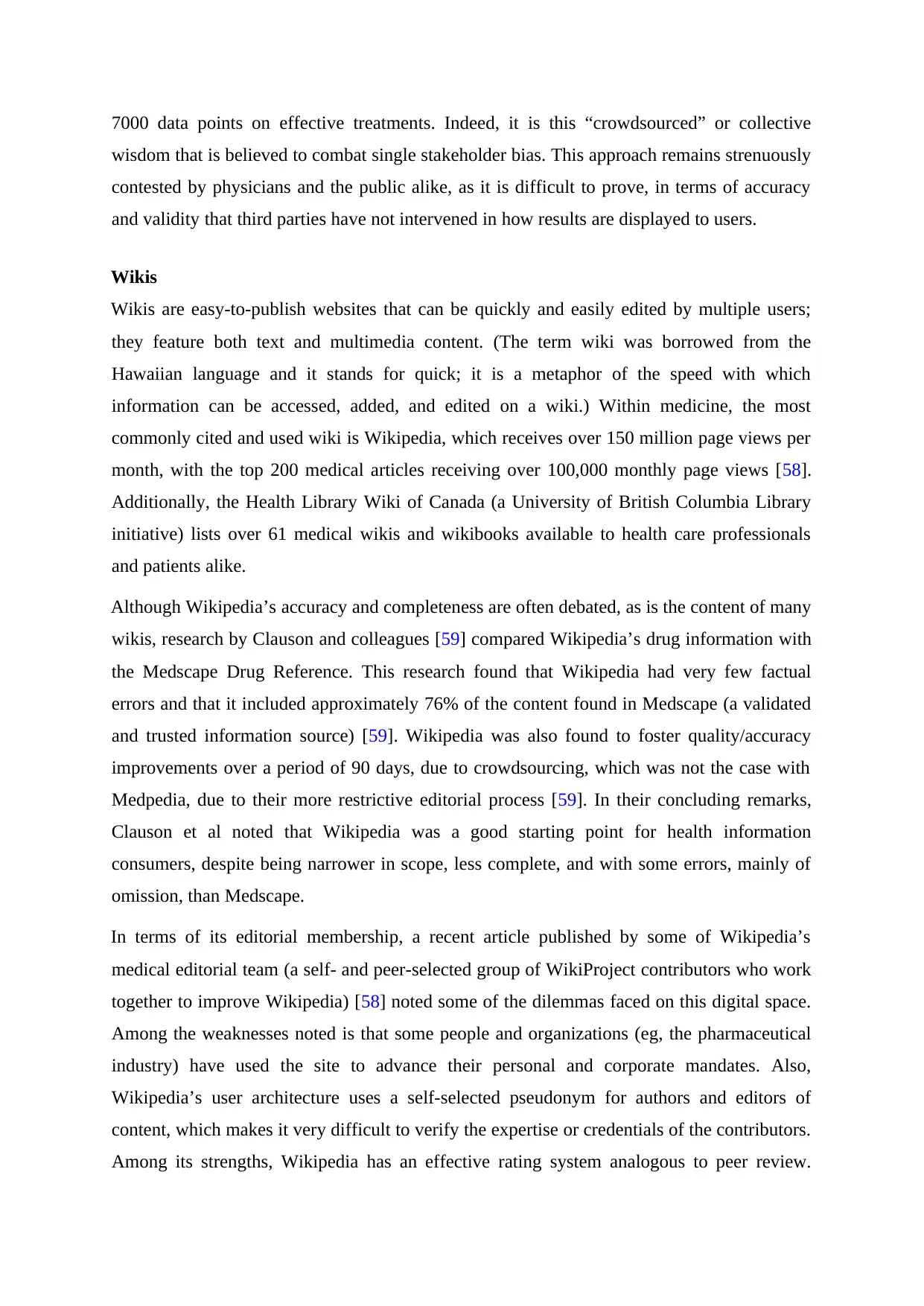
7000 data points on effective treatments. Indeed, it is this “crowdsourced” or collective
wisdom that is believed to combat single stakeholder bias. This approach remains strenuously
contested by physicians and the public alike, as it is difficult to prove, in terms of accuracy
and validity that third parties have not intervened in how results are displayed to users.
Wikis
Wikis are easy-to-publish websites that can be quickly and easily edited by multiple users;
they feature both text and multimedia content. (The term wiki was borrowed from the
Hawaiian language and it stands for quick; it is a metaphor of the speed with which
information can be accessed, added, and edited on a wiki.) Within medicine, the most
commonly cited and used wiki is Wikipedia, which receives over 150 million page views per
month, with the top 200 medical articles receiving over 100,000 monthly page views [58].
Additionally, the Health Library Wiki of Canada (a University of British Columbia Library
initiative) lists over 61 medical wikis and wikibooks available to health care professionals
and patients alike.
Although Wikipedia’s accuracy and completeness are often debated, as is the content of many
wikis, research by Clauson and colleagues [59] compared Wikipedia’s drug information with
the Medscape Drug Reference. This research found that Wikipedia had very few factual
errors and that it included approximately 76% of the content found in Medscape (a validated
and trusted information source) [59]. Wikipedia was also found to foster quality/accuracy
improvements over a period of 90 days, due to crowdsourcing, which was not the case with
Medpedia, due to their more restrictive editorial process [59]. In their concluding remarks,
Clauson et al noted that Wikipedia was a good starting point for health information
consumers, despite being narrower in scope, less complete, and with some errors, mainly of
omission, than Medscape.
In terms of its editorial membership, a recent article published by some of Wikipedia’s
medical editorial team (a self- and peer-selected group of WikiProject contributors who work
together to improve Wikipedia) [58] noted some of the dilemmas faced on this digital space.
Among the weaknesses noted is that some people and organizations (eg, the pharmaceutical
industry) have used the site to advance their personal and corporate mandates. Also,
Wikipedia’s user architecture uses a self-selected pseudonym for authors and editors of
content, which makes it very difficult to verify the expertise or credentials of the contributors.
Among its strengths, Wikipedia has an effective rating system analogous to peer review.
wisdom that is believed to combat single stakeholder bias. This approach remains strenuously
contested by physicians and the public alike, as it is difficult to prove, in terms of accuracy
and validity that third parties have not intervened in how results are displayed to users.
Wikis
Wikis are easy-to-publish websites that can be quickly and easily edited by multiple users;
they feature both text and multimedia content. (The term wiki was borrowed from the
Hawaiian language and it stands for quick; it is a metaphor of the speed with which
information can be accessed, added, and edited on a wiki.) Within medicine, the most
commonly cited and used wiki is Wikipedia, which receives over 150 million page views per
month, with the top 200 medical articles receiving over 100,000 monthly page views [58].
Additionally, the Health Library Wiki of Canada (a University of British Columbia Library
initiative) lists over 61 medical wikis and wikibooks available to health care professionals
and patients alike.
Although Wikipedia’s accuracy and completeness are often debated, as is the content of many
wikis, research by Clauson and colleagues [59] compared Wikipedia’s drug information with
the Medscape Drug Reference. This research found that Wikipedia had very few factual
errors and that it included approximately 76% of the content found in Medscape (a validated
and trusted information source) [59]. Wikipedia was also found to foster quality/accuracy
improvements over a period of 90 days, due to crowdsourcing, which was not the case with
Medpedia, due to their more restrictive editorial process [59]. In their concluding remarks,
Clauson et al noted that Wikipedia was a good starting point for health information
consumers, despite being narrower in scope, less complete, and with some errors, mainly of
omission, than Medscape.
In terms of its editorial membership, a recent article published by some of Wikipedia’s
medical editorial team (a self- and peer-selected group of WikiProject contributors who work
together to improve Wikipedia) [58] noted some of the dilemmas faced on this digital space.
Among the weaknesses noted is that some people and organizations (eg, the pharmaceutical
industry) have used the site to advance their personal and corporate mandates. Also,
Wikipedia’s user architecture uses a self-selected pseudonym for authors and editors of
content, which makes it very difficult to verify the expertise or credentials of the contributors.
Among its strengths, Wikipedia has an effective rating system analogous to peer review.
⊘ This is a preview!⊘
Do you want full access?
Subscribe today to unlock all pages.

Trusted by 1+ million students worldwide
1 out of 33
Related Documents
Your All-in-One AI-Powered Toolkit for Academic Success.
+13062052269
info@desklib.com
Available 24*7 on WhatsApp / Email
![[object Object]](/_next/static/media/star-bottom.7253800d.svg)
Unlock your academic potential
Copyright © 2020–2025 A2Z Services. All Rights Reserved. Developed and managed by ZUCOL.





